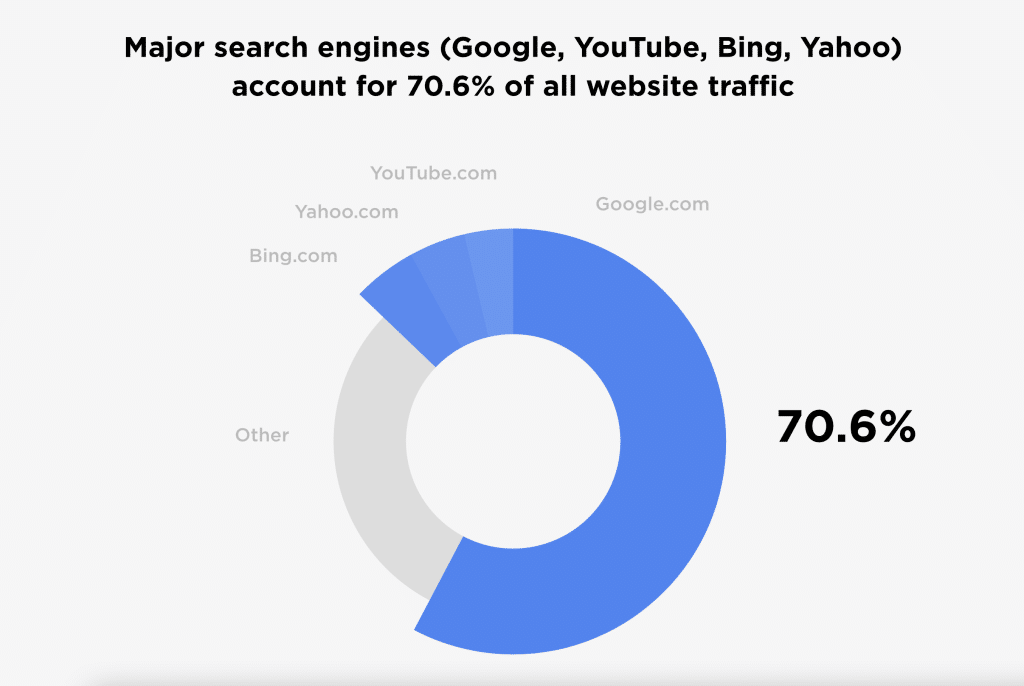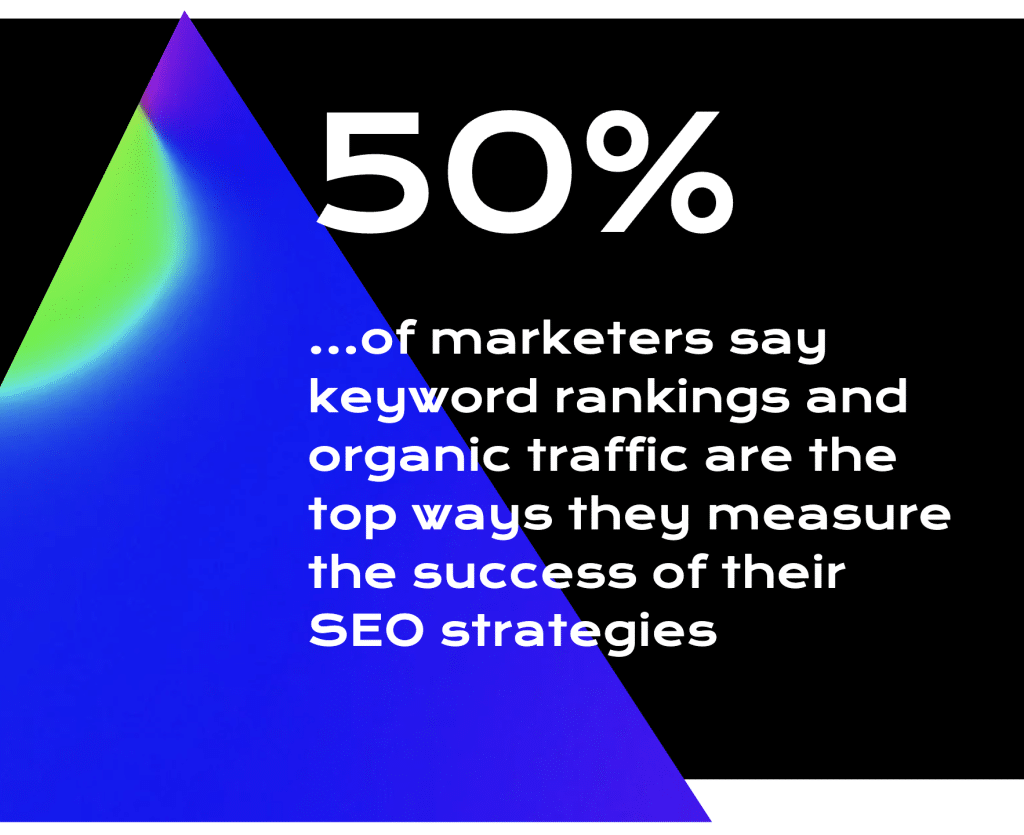
Securing a top spot on Google’s search results is like striking gold. With a staggering 2/3 of all clicks being awarded to the first 5 organic search results, the competition is fiercer than ever.
Yet, even with an impressive SEO strategy, top-notch content, and meticulous technical SEO audits, there’s no guaranteed ticket to the spotlight. A whopping 90% of web pages remain ghost towns, receiving zero search traffic from Google.
So, if your content isn’t drawing the masses, whose is? The answer lies with your competitors.
If your competitors are mastering the SEO game and outperforming you at every turn, your chances of shining bright in the search results start to fade. But instead of viewing competitors as a thorn in your side, why not see them as a goldmine of insights? This is where the magic of SEO competitor analysis comes in.
By embracing this approach, competitors transform from foes into friends. When executed with precision, SEO competitor analysis paves the way for creating superior content, climbing the search engine ladder, and pulling relevant traffic to your digital doorstep.
Quick Takeaways
- Major search engines dominate web traffic, with Google, YouTube, and Bing accounting for 70.6% of all visits, highlighting the vital role of SEO.
- Understanding your website’s strengths and weaknesses is foundational, with tools like Google Analytics offering insights into traffic-driving keywords and areas for improvement.
- Identifying actual online competitors can be surprising, but with SEO tools and key metrics, you can gain a comprehensive view of your competitive landscape.
- Insights from competitor analysis should guide a robust SEO strategy, emphasizing clear goals, adaptability, audience engagement, and continuous refinement.
Understanding the Basics of SEO Competitor Analysis
Major search engines, like Google, YouTube, and Bing, account for 70.6% of all website traffic. As a website owner, it’s your job to prioritize SEO so you can turn organic traffic into conversions.

Image Source: Backlinko
But when you’re entering the world of SEO, it’s not just about understanding your own website’s strengths and weaknesses. It’s also about knowing what your competitors are up to. Let’s break down the basics together.
Understanding Your Own SEO Profile
Before we start peeking into what others are doing, let’s take a moment to reflect on our own website. Why? Because knowing where you stand sets the foundation for any analysis.
- Know your strengths. We like to use tools like Google Analytics to see which keywords are driving traffic to our site.
- Spot the weaknesses. Are there pages with high bounce rates? Maybe some content isn’t resonating as well as you thought. Identifying these areas means you can work on them.
Identifying Your Main Competitors
You might think you know who your competitors are, but the online world can surprise you. Here’s how to pinpoint them:
- Start with a simple Google search. Type in your main keywords and see who pops up. Those are the websites you’re competing with for attention.
- Use SEO tools. There are so many tools out there, like SEMrush or Ahrefs, that can give you a list of competitors based on shared keywords.
Key Metrics to Consider
Now, when you’re looking at your competitors, what should you focus on? Here are some key metrics that can give you a clear picture:
- Organic traffic. The first 5 organic results in SERPs account for 67.6% of all clicks. Take a look at how many people are finding your competitors’ sites naturally through search engines. This gives you an idea of their SEO strength.
- Keyword rankings. Over 50% of marketers say keyword rankings and organic traffic are the top ways to measure SEO strategy success. So, which keywords are your competitors ranking for? And more importantly, are there any you’ve missed?

Image Source: Avidly
- Backlink profile. Backlinks are like votes of confidence from other websites. Who’s linking to them? And how can you get similar links?
- On-page elements. Take a look at their meta tags, content quality, and site structure. Are they doing something you’re not?
Remember, this isn’t about copying what others are doing. It’s about understanding the landscape, finding gaps, and then carving out your own unique space.
Diving Deep into SEO Competitor Analysis
Alright, now that we’ve covered the basics, let’s roll up our sleeves and dig a little deeper. This is where the real magic happens.
Analyzing Competitor Keywords
Keywords are the backbone of SEO. They’re the words and phrases your potential customers type into search engines.
So, understanding which ones your competitors are targeting can be a goldmine of information.
- Spot their top performers. Tools like Moz or Ubersuggest can show you which keywords your competitors are ranking high for. Are there any that you haven’t thought of?
- Find the gaps. Maybe there are keywords they’ve overlooked, but you see potential in. Those are opportunities waiting for you to seize.
Backlink Analysis
Think of backlinks as the popularity contest of the internet. The more quality sites that link to yours, the better.
Ironically, more than 66% of websites have zero backlinks that refer back to them. This means that if you do have backlinks, you’re already one step ahead of the game.

Image Source: Victorious
But let’s not forget one of the most important questions: Who’s linking to your competitors?
- Discover their allies. Using tools like Ahrefs, you can see which websites link to your competitors. Are there industry blogs or news sites you should be reaching out to?
- Quality over quantity. Remember, it’s not just about the number of backlinks, but the quality. A link from a reputable source is worth its weight in gold.
On-Page SEO Analysis
This is where we peek under the hood and see how your competitors’ sites are built. It’s the nitty-gritty details that can make a big difference.
- Content is king. Check out their blogs, articles, and landing pages. Is their content engaging and relevant? How does yours compare?
- Meta matters. Look at their meta titles and descriptions. These tiny snippets can influence click-through rates from search results.
- User experience (UX). How easy is it to navigate their site? Is it mobile-friendly? A great user experience has the power to boost SEO, so take notes.
By exploring these areas, you’re not just understanding your competitors better, but also finding ways to outshine them. And with the insights you gather, you’ll be well on your way to climbing those search engine rankings.
Creating an SEO Strategy Based on Competitor Analysis
So, you’ve done the research, peeked at your competitors, and gathered a ton of insights. Now what? It’s time to take all that knowledge and craft a killer SEO strategy.
1. Use Your Insights as a Launchpad
Start by embracing your strengths. If there are areas where you’re already outperforming your competitors, keep up the good work.
On the flip side, if competitors are ahead in certain aspects, take note. This becomes your to-do list. Whether it’s targeting new keywords or enhancing your content, it’s essential to know where to channel your efforts.
2. Set SMART Goals
While it’s commendable to aim for the stars, it’s equally important to be realistic. If you’re aspiring to rank #1 for a specific keyword, break down the journey. Perhaps initially aim for the top 10.
At MIG, we like to set SMART goals: Specific, Measurable, Actionable, Relevant and Time-bound. This helps ensure that what we’re aiming to achieve is within reach.
Video Source: FlikliTV
Along the way, think about using tools like Google Search Console. They help you track your progress and pave the way for bigger achievements.
3. Prioritize Your Actions
Content remains king in the digital realm. Always prioritize crafting top-notch content that you’d find both useful and engaging.
But don’t forget about backlinks. Those reputable sites linking to your competitors? They’re potential goldmines. Reach out, share your content, and focus on building meaningful relationships in the industry.
4. Stay Adaptable
The world of SEO is ever-evolving. What’s effective today might not hold the same weight tomorrow, thanks to the ever-changing search engine algorithms.
So, flexibility in your strategy is key. And as you adapt and grow, remember that your competitors are on a similar journey. Regularly revisiting your competitor analysis ensures you stay one step ahead.
5. Engage Your Audience
Your audience is a treasure trove of insights. Encourage them to comment and provide feedback on your content. Their perspectives can open doors to avenues you hadn’t considered.
Additionally, in this age of connectivity, it’s vital to stay social. Share your content on various platforms, engage in meaningful discussions, and ensure you’re present where your audience spends most of their time.
6. Make Regular Updates
Creating an SEO strategy isn’t a one-time task. It’s an ongoing process. But with the insights from your competitor analysis in hand, you’re already several steps ahead.
Stay curious, stay adaptable, and most importantly, stay focused on providing value. That’s the real secret to SEO success.
Harness the Power of Strategic SEO Competitor Analysis Today!
By diving deep into your own website’s strengths and weaknesses, and comparing them against your competitors, you gain invaluable insights. These insights, when harnessed correctly, pave the way for a robust SEO strategy.
From keyword targeting and backlink building to engaging content and audience interaction, every facet plays a pivotal role. But remember, the digital realm is ever-evolving.
So, while it’s essential to craft a strategy, it’s equally vital to remain adaptable and open to change. With dedication, continuous learning, and a keen eye on the competition, you’re well on your way to SEO success.
Are you ready to create the ultimate SEO strategy? Check out our SEO Blog Writing Service or schedule a quick consultation to learn more about how Marketing Insider Group can help you earn more traffic and leads for your business.


0 Commentaires